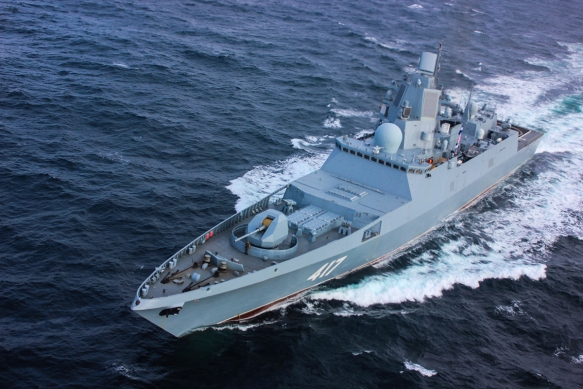
Russian Frigate Admiral Gorshkov
Admiral Gorshkov (417) is an Admiral Gorshkov class frigate of the Russian Navy and the lead ship of the class. The ship is named after Hero of the Soviet Union Sergey Gorshkov.
The vessel was laid down on 1 February 2006, launched on 29 October 2010 and commissioned on 28 July 2018 with Russia’s Northern Fleet.
Admiral Gorshkov-class frigates displace 4,500 tonnes and can develop a speed of 29 knots. They are armed with P-800 Oniks and Kalibr anti-ship and land-attack cruise missiles, and the Poliment-Redut air defense missile system.
MOSCOW, March 20. /TASS/. The Russian Navy expects to accept the latest Tsirkon hypersonic missile for service and deploy it on warships and submarines from 2023, a source in the defense industry told TASS on Wednesday.
“The state trials of the Tsirkon conducted from the basic sea carriers are planned to be completed in 2022 and from 2023 the missile will be accepted for service and put on combat duty,” the source said.
The Russian Navy expects to arm all the new and modernized surface ships and nuclear-powered submarines, including Project 22350 and Project 22350M frigates, the heavy nuclear-powered missile cruisers Admiral Nakhimov and Pyotr Veliky, Yasen-class submarines and Lider-class nuclear-powered destroyers slated for construction with Tsirkon hypersonic missiles, the source said.
Hypersonic Cruise Missiles
An HCM on the other hand, is typically propelled to high speeds (around Mach 4 to 5) initially using a small rocket; thereafter, an air-breathing supersonic combustion ram jet or a `scramjet’ accelerates it further and maintains its hypersonic speed. HCMs are hypersonic versions of existing cruise missiles but would cruise at altitudes of 20-30 km in order to ensure adequate pressure for its scramjet. Standard cruise missiles are difficult to intercept-and the speed of the HCM and the altitude at which it travels complicates this task of interception manifold. The United States’ underdevelopment `WaveRider’ is a typical HCM. Russia’s HCM, the aircraft-launched Kh-47M2 `Kinzhal’, (Dagger), has a reported top speed of Mach-10 and a range of about 2000 km. India’s underdevelopment `Hyper Sonic Technology Demonstrator Vehicle’ (HSTDV) too, capable of speeds around Mach-7, falls in the category of an HCM.
1. Aerial vehicles that can travel in excess of Mach-5 are labelled as hypersonic.
2. Three nations (Russia, China, USA) have been testing hypersonic glide vehicles (HGVs), although a number of other countries are also pursuing hypersonic programmes.
3. An HGV, armed with a nuclear or a conventional warhead, or merely relying on its kinetic energy, has the potential to allow a military to rapidly and pre-emptively strike distant targets anywhere on the globe within hours or less.
4. On account of their quick-launch capability, high speed, lower altitude and higher manoeuvrability vis-a-vis Intercontinental Ballistic Missiles , HGVs are difficult to detect and intercept with existing air and missile defence systems.
5. This capability could tempt a nation to consider using HGVs for a disarming and first-strike on an adversary’s nuclear arsenal.
6. While numerous challenges remain, operational deployment of HGVs would thus compel target nations to set their nuclear forces on a hair-trigger readiness and “launch on warning” alerts, leading also to the devolution of command over nuclear weapons.
7. Overall, this would aggravate strategic instability, and also generate unacceptable levels of instability in crisis management at many levels.